The Nashville Predators entered the 2018-19 season as one of the favorites to make a deep playoff run and were among the handful of teams viewed as a serious Stanley Cup contender. This season hasn’t gone as expected. Sure, they won the Central Division but were never in the same conversation as the Tampa Bay Lightning.
Recently, however, they’ve played better, with a 7-2-1 record in their final 10 games, with some gutsy wins included. But despite their recent strong play, the Predators have areas that need focused on for them to have playoff success. While there are likely more, here are five keys for the Predators to make a deep postseason run.
Continued Second Line Chemistry
For nearly the entirety of the 2018-19 season, the Predators struggled to score. They totaled 236 goals, third-fewest among playoff teams, and their bottom three lines accounted for just 27 percent of the team’s goals, with their second line being the biggest culprit. Kyle Turris was a disappointment with only seven goals and 23 points and Kevin Fiala only had 10 goals and 32 points before he was traded to the Minnesota Wild.
Related: Turris Trade a Year Later
Factor in that Mikael Granlund only contributed one goal and five points in the 16 games after the Predators acquired him, and Craig Smith was the only consistent producer on the line with 21 goals and 38 points. This lack of depth offense was problematic all season, and if it isn’t fixed for the postseason, the Predators won’t make it far.
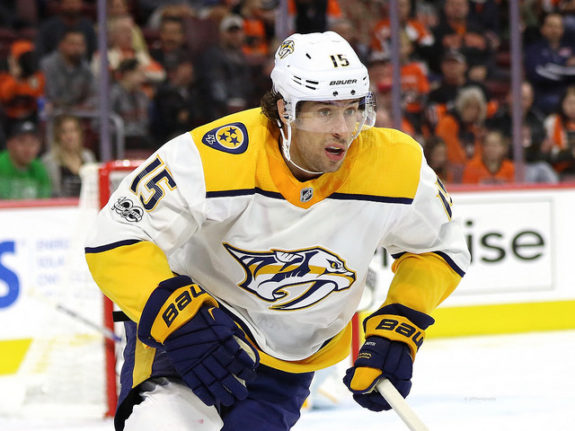
When general manager David Poile acquired Granlund at the trade deadline, it was to bolster the second line, replacing Fiala and leading to a newly-formed unit of Granlund, Turris and Smith. However, given Turris’ struggles since the Predators traded for him in Nov. 2017, the second line never found chemistry and wasn’t productive, before or after the trade deadline. Luckily, in recent games, there has been some turnaround from the trio.
In the Predators’ last three games, all wins, the second line has done its part. Only Smith has scored, but all three have added an assist. Furthermore, the line is controlling play at five-on-five, and by a wide margin. The unit played at least 10:49 together in all three games, including a team-high 12:39 against the Buffalo Sabres on April 2. The line also controlled at least 57 percent of shots in each game, including 70.6 percent versus Buffalo.
Beyond the metrics, the line looked better than it did all season. Starting in the offensive zone a majority of the time, the trio succeeded in cycling the puck and generated high-danger scoring chances. Turris looked more engaged, was strong on the forecheck, made the right passes and backchecked well. It’s quite a difference from the recent rumors surrounding his displeasure in Nashville. The Predators will need an engaged Turris and a productive second line to advance in the postseason.
Heavy Reliance on the JOFA Line
But any strong play the Predators get from the second line will be complementary on top of what the JOFA line – the team’s top line of Ryan Johansen, Filip Forsberg and Viktor Arvidsson – brings. The line was by far the team’s most productive unit, and one of the most dynamic top lines in the league, with a 55.5 percent shot share, a 57.9 percent goal share and a 56.5 percent control of scoring chances.
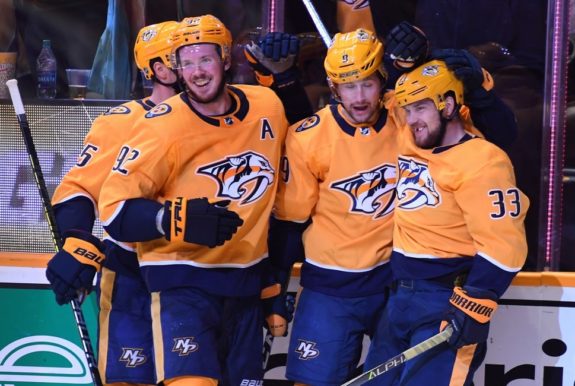
The line represented 26 percent of the team’s points and they were three of the team’s top four scorers in the regular season. Arvidsson and Forsberg were the team’s top goal scorers, with 34 and 28, respectively, and Johansen led the team with 50 assists and 64 points. But not only is the line expected to produce offensively, head coach Peter Laviolette starts them in all three zones. Add in that Johansen won 53.5 percent of faceoffs, and the Predators need the JOFA line to continue succeeding to win in the postseason.
The line regularly played the most of Predators’ lines and that’s expected to continue when the playoffs start. Laviolette will lean on the trio to produce, defend and control play. If the other lines produce, it will take the strain off the JOFA line, but make no bones about it, the line will need to be the driving force up front.
Increased Offense from the Blue Line
For more than a decade, the Predators have been best known for their great defenses. What started with Kimmo Timonen, Shea Weber and Ryan Suter has become Roman Josi, Ryan Ellis, P.K. Subban and Mattias Ekholm. Their blue line has been deep enough to part with Seth Jones and Samuel Girard and not miss a beat. The defensive talent has led to the Predators’ offense going through their blue line.
This season has been no different in that the team relies heavily on scoring from defensemen. The problem, however, is that they weren’t as successful as in recent seasons. In 2018-19, Predators blueliners totaled 43 goals and 197 points. That’s a pretty lofty total, until you compare it to the San Jose Sharks’ 221 points from defensemen, or even the 206 points the Predators received in 2017-18 from the position.
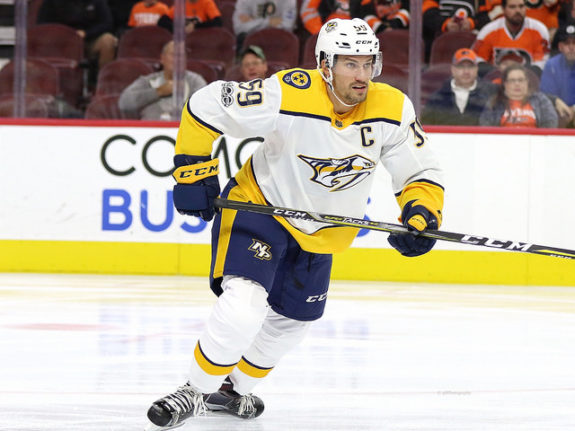
This season’s regression could be blamed on Subban missing 19 games, but Ellis missed 38 games and Josi missed seven last season. What’s interesting about 2018-19 is that individually the Predators’ top four blueliners had their five-on-five rate stats stay steady relative to last season, particularly in offensive generation.
Where the regression is evident is on the power play, unsurprising as the team had the league’s worst during the regular season. All four of the Predators’ top defensemen had their rate stats regress on the man advantage this season. So, assuming the team doesn’t all of a sudden become a lethal power play, the defensemen need to do everything to maximize their offensive potential.
This starts with being more active in the offensive zone. For the most part, Josi and Ekholm were the two Predators blueliners who consistently jumped up in the play and generated scoring chances deep in the zone. Subban did it more in recent weeks as he recovered from injury, but Ellis was largely absent offensively this season.
A positive is that Subban played his best hockey of the season recently, Josi had 50-plus points for the fourth time in five seasons and the influx of rookie Dante Fabbro brought some offense from the third pair. Plus, Ekholm was solid in all three zones all season. That leaves Ellis, who needs to find his game once the playoffs start.
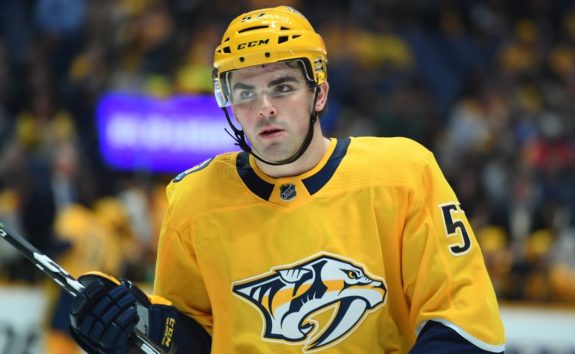
If the defensemen aren’t going to produce at high levels on the man advantage, they need to find ways to generate chances at even strength, and it starts with leading rushes, pinching in the offensive zone and jumping into the cycle to alter shooting angles. The path to a Stanley Cup starts at the blue line, and an improvement in play has to begin with Game 1 of the first round.
Get the Puck Down Low on the Power Play
As I alluded to in the previous section, the Predators’ power play was terrible during the regular season. They converted on a league-worst 12.9 percent of opportunities and their 33 power play goals tied for 29th.
They ranked 24th in shot attempts per-60 minutes on the power play, 27th in scoring chances per-60, 30th in high-danger chances per-60 and 31st in goals scored per-60. Oh, and they shot a league-worst 9.4 percent on the man advantage. Why, you ask? The obvious reason is that they deployed three forwards and two defensemen the majority of the season while most teams use four forwards and one defenseman. It wasn’t until Granlund arrived that Laviolette went with four forwards, and the power play instantly became more of a threat.
Relying on shot generation from the blue line while on the man advantage isn’t a recipe for success. The distance is too far and it allows penalty killers the opportunity to clog shooting lanes and the time to clear the puck. The heat maps below show the difference from where the Predators attempted shots on the power play and where the Lightning, with the league’s best power play, attempted their shots from.
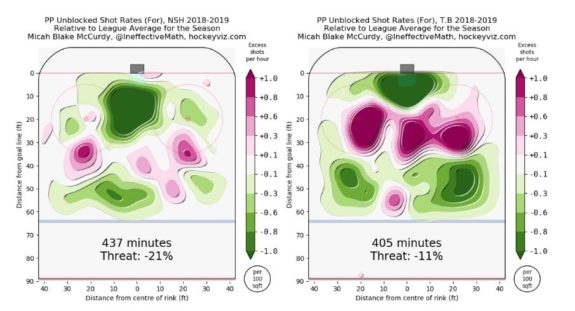
The majority of Predators shots originated from the top of the faceoff circles, if not beyond them, while Lightning shots came almost exclusively from below the top of the faceoff circle. The decision of where to shoot from is a big deal, and it’s something the Predators need to change in the playoffs when successful power plays are key to winning.
Related: Predators’ Power Play – Good Enough for Cup Run?
That’s why I think the team needs to focus on getting the puck down low. Poile acquired Brian Boyle and Wayne Simmonds to be net-front presences on the man advantage, but their impact is capped when the team shoots from beyond the faceoff circles. Instead, the team needs to keep Boyle and Simmonds in front of the net, but another forward needs to be in the low slot to play the ‘bumper’ position.
Defensemen are still important in this setup as Josi is as dangerous with the puck as most forwards and Subban has a bomb from the point. The difference is not relying on the point-to-point pass, but rather working the puck from outside the slot to inside it and from up high to down low, and vice versa. By working the puck down low, there’s less reaction time for the goaltender and penalty killers.
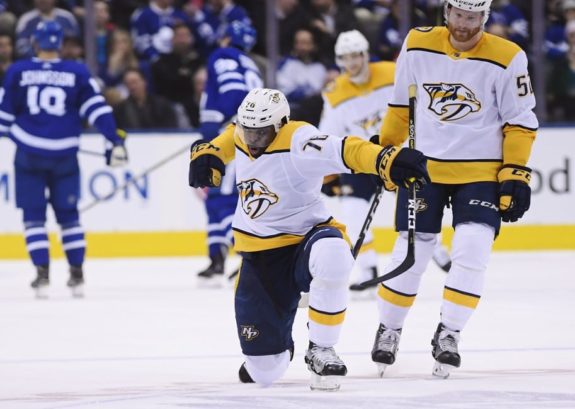
The Predators have the talent to have a successful power play, they just need to utilize it better. The majority of games may be played at even strength, but a threatening power play is vital to winning in the postseason, even if it’s just opponents being fearful of taking penalties.
Consistency in Net & a Quick Hook for Rinne
Ultimately, though, all the keys listed above are secondary to what occurs in net. Talent-wise, the Predators have one of the best goaltending tandems in the league with Pekka Rinne and Juuse Saros. Last season, Rinne won the Vezina Trophy after he posted a .927 save percentage (SV%) and a 2.31 goals-against average (GAA) in 59 games while Saros had a .925 SV% and a 2.45 GAA in 26 appearances as Rinne’s backup. In the postseason, though, Rinne was bad.
In 13 games, he had a 7-6-0 record with a .904 SV% and a 3.07 GAA. He allowed four or more goals in five games and was pulled in four. When he was on his game, he was nearly unbeatable, but there were too many times when he didn’t give the team a chance.
Meanwhile, Saros had a .952 SV% and a 1.06 GAA in four appearances, all in relief of Rinne. He allowed two goals, both in Game 7 of the second round. The Predators lost all four games he played in, but he didn’t receive a decision in any of them as the games were too far out of hand when he was called upon. Had Laviolette had a quicker hook with Rinne, perhaps the Predators would have had an easier time getting past the Colorado Avalanche and could have beat the Winnipeg Jets.
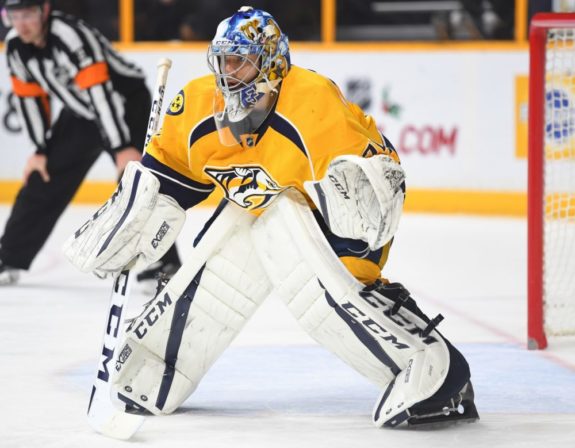
Fast-forward to 2018-19 and the goaltending wasn’t as reliable. Sure the team had a .914 SV%, fourth-highest in the league, but neither goalie was particularly great. In 56 appearances, Rinne had a .918 SV% and a 2.42 GAA, while Saros had a .915 SV% and a 2.62 GAA in 31 appearances. Rinne allowed three-plus goals in 25 games and was generally inconsistent. Saros struggled with inconsistent play, as well, with 11 games of at least four goals allowed.
Both goaltenders played somewhat better down the stretch, with Saros posting a save percentage at or above .920 in four of his final six appearances and Rinne doing so in seven of his final eight. He also won his final four appearances. Teams can make the playoffs without Vezina-caliber play, but it’s hard to advance far in the postseason without strong netminding.
Rinne has a history of struggling in the playoffs, with a sub-.910 SV% in four of the seven postseasons he’s played in. Even in 2017, when the Predators reached the Stanley Cup Final for the first time in franchise history, he struggled, especially in the Final when he was pulled in two of six games.
This postseason, Rinne has to be more consistent than he’s ever been. He can’t pitch a shutout one game and in the next allow five goals. And if he does struggle, Laviolette needs to have a quick hook and get Rinne out of the net sooner rather than later. Giving the team the best chance to win is more important than sticking with Rinne simply because he’s the starter.
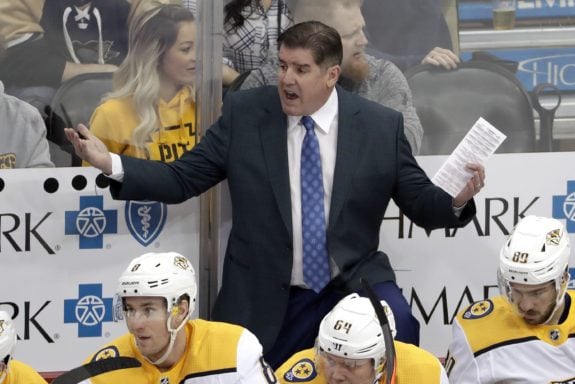
A Recipe for Success in the Postseason
I believe that if the Predators stick to the five keys listed above, they have a strong shot to advance to at least the conference finals. They have been Stanley Cup contenders in recent seasons, but have failed to achieve their ultimate goal. With a core that’s in its peak, the time to go on another deep playoff run is now.
*All stats from Natural Stat Trick and Hockey-Reference